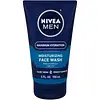What's inside
What's inside
 Key Ingredients
Key Ingredients

No key ingredients
 Benefits
Benefits

 Concerns
Concerns

 Ingredients Side-by-side
Ingredients Side-by-side

Water
Skin ConditioningCocamidopropyl Betaine
CleansingSodium Myreth Sulfate
CleansingDecyl Glucoside
CleansingGlycerin
HumectantPanthenol
Skin ConditioningAloe Barbadensis Leaf Juice
Skin ConditioningMenthol
MaskingAlcohol Denat.
AntimicrobialAcrylates/C10-30 Alkyl Acrylate Crosspolymer
Emulsion StabilisingPhenoxyethanol
PreservativePEG-90 Glyceryl Isostearate
CleansingPEG-40 Hydrogenated Castor Oil
EmulsifyingParfum
MaskingPolyquaternium-10
Laureth-2
CleansingBenzophenone-4
UV AbsorberSodium Hydroxide
BufferingMethylparaben
PreservativeEthylparaben
PreservativeBlue 1 Lake
Cosmetic ColorantWater, Cocamidopropyl Betaine, Sodium Myreth Sulfate, Decyl Glucoside, Glycerin, Panthenol, Aloe Barbadensis Leaf Juice, Menthol, Alcohol Denat., Acrylates/C10-30 Alkyl Acrylate Crosspolymer, Phenoxyethanol, PEG-90 Glyceryl Isostearate, PEG-40 Hydrogenated Castor Oil, Parfum, Polyquaternium-10, Laureth-2, Benzophenone-4, Sodium Hydroxide, Methylparaben, Ethylparaben, Blue 1 Lake
Aloe Barbadensis Leaf Juice
Skin ConditioningWater
Skin ConditioningSodium Cocoamphoacetate
CleansingCocamidopropyl Betaine
CleansingSodium Cocoyl Glutamate
CleansingSodium Lauroyl Sarcosinate
CleansingCoco-Glucoside
CleansingLauryl Glucoside
CleansingMelaleuca Alternifolia Leaf Oil
AntioxidantCitrus Nobilis Oil
MaskingCitrus Bergamia Peel Oil Expressed
PerfumingCitrus Limon Peel Oil
MaskingCedrus Deodara Wood Oil
MaskingCitrus Paradisi Peel Oil
MaskingHamamelis Virginiana Leaf Extract
Skin ConditioningPyrus Malus Fruit Extract
Skin ConditioningSalix Alba Bark Extract
AstringentSambucus Nigra Flower Extract
RefreshingHydroxypropyl Oxidized Starch Pg-Trimonium Chloride
HumectantStarch Hydroxypropyltrimonium Chloride
Emulsion StabilisingGlycerin
HumectantLactic Acid
BufferingSodium Lactate
BufferingUrea
BufferingGlyceryl Laurate
EmollientSodium Chloride
MaskingCitric Acid
BufferingLevulinic Acid
PerfumingP-Anisic Acid
MaskingSodium Benzoate
MaskingPotassium Sorbate
PreservativeLimonene
PerfumingLinalool
PerfumingCitral
PerfumingGeraniol
PerfumingAloe Barbadensis Leaf Juice, Water, Sodium Cocoamphoacetate, Cocamidopropyl Betaine, Sodium Cocoyl Glutamate, Sodium Lauroyl Sarcosinate, Coco-Glucoside, Lauryl Glucoside, Melaleuca Alternifolia Leaf Oil, Citrus Nobilis Oil, Citrus Bergamia Peel Oil Expressed, Citrus Limon Peel Oil, Cedrus Deodara Wood Oil, Citrus Paradisi Peel Oil, Hamamelis Virginiana Leaf Extract, Pyrus Malus Fruit Extract, Salix Alba Bark Extract, Sambucus Nigra Flower Extract, Hydroxypropyl Oxidized Starch Pg-Trimonium Chloride, Starch Hydroxypropyltrimonium Chloride, Glycerin, Lactic Acid, Sodium Lactate, Urea, Glyceryl Laurate, Sodium Chloride, Citric Acid, Levulinic Acid, P-Anisic Acid, Sodium Benzoate, Potassium Sorbate, Limonene, Linalool, Citral, Geraniol
Ingredients Explained
These ingredients are found in both products.
Ingredients higher up in an ingredient list are typically present in a larger amount.
Aloe Barbadensis Leaf Juice comes from leaves of the aloe plant. Aloe Barbadensis Leaf Juice is best known for helping to soothe sunburns. It is also anti-inflammatory, moisturizing, antiseptic, and can help heal wounds.
Aloe is packed with good stuff including Vitamins A, C, and E. These vitamins are antioxidants, which help fight free-radicals and the damage they may cause. Free-radicals are molecules that may damage your skin cells, such as pollution.
Aloe Barbadensis Leaf Juice also contains sugars. These sugars come in the form of monosaccharides and polysaccharides, folic acid, and choline. These sugars are able to help bind moisture to skin.
It also contains minerals such as calcium, 12 anthraquinones, fatty acids, amino acids, and Vitamin B12.
Learn more about Aloe Barbadensis Leaf JuiceCocamidopropyl Betaine is a fatty acid created by mixing similar compounds in coconut oil and dimethylaminopropylamine, a compound with two amino groups.
This ingredient is a surfactant and cleanser. It helps gather the dirt, pollutants, and other impurities in your skin to be washed away. It also helps thicken a product and make the texture more creamy.
Being created from coconut oil means Cocamidopropyl Betaine is hydrating for the skin.
While Cocamidopropyl Betaine was believed to be an allergen, a study from 2012 disproved this. It found two compounds in unpure Cocamidopropyl Betaine to be the irritants: aminoamide and 3-dimethylaminopropylamine. High-grade and pure Cocamidopropyl Betaine did not induce allergic reactions during this study.
Learn more about Cocamidopropyl BetaineGlycerin is already naturally found in your skin. It helps moisturize and protect your skin.
A study from 2016 found glycerin to be more effective as a humectant than AHAs and hyaluronic acid.
As a humectant, it helps the skin stay hydrated by pulling moisture to your skin. The low molecular weight of glycerin allows it to pull moisture into the deeper layers of your skin.
Hydrated skin improves your skin barrier; Your skin barrier helps protect against irritants and bacteria.
Glycerin has also been found to have antimicrobial and antiviral properties. Due to these properties, glycerin is often used in wound and burn treatments.
In cosmetics, glycerin is usually derived from plants such as soybean or palm. However, it can also be sourced from animals, such as tallow or animal fat.
This ingredient is organic, colorless, odorless, and non-toxic.
Glycerin is the name for this ingredient in American English. British English uses Glycerol/Glycerine.
Learn more about GlycerinWater. It's the most common cosmetic ingredient of all. You'll usually see it at the top of ingredient lists, meaning that it makes up the largest part of the product.
So why is it so popular? Water most often acts as a solvent - this means that it helps dissolve other ingredients into the formulation.
You'll also recognize water as that liquid we all need to stay alive. If you see this, drink a glass of water. Stay hydrated!
Learn more about Water